Comic Strip Spread
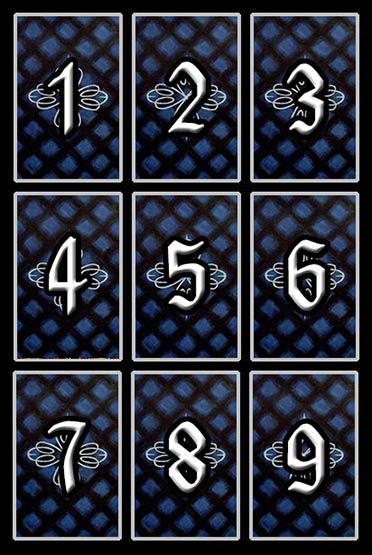
Difficulty: Easy
Note: This spread works best with decks like the Diary of a Broken Soul or Surrealist Tarot because they display scenes rather than pips and do not use reversals.
The Comic Strip Spread is a simple nine-card chronological spread that looks like a page of a comic book. This method should be used to get a glimpse of the future as it would pan out naturally. It may be insightful to use this spread in coordination with biorhythms. The spread is easy to read as a storyboard, just like a comic strip.
The main subject is apparent in the first card, while the story plays out through the following tarot cards.
It is important to pay particular attention to the cards and the relationships with their neighbours. Notice which directions the cards are facing, and how they interact.
Your Comic Strip Reading
10 of Wands |
8 of Swords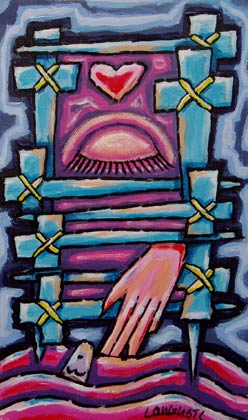 |
Queen of Swords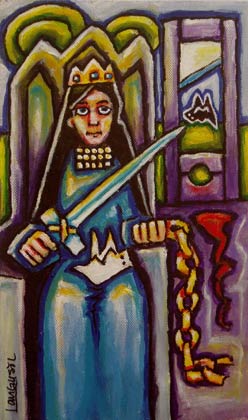 |
4 of Swords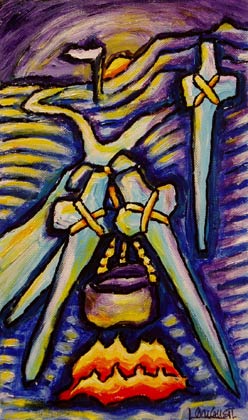 |
The Tower |
Strength |
Prince of Swords |
The Empress |
9 of Cups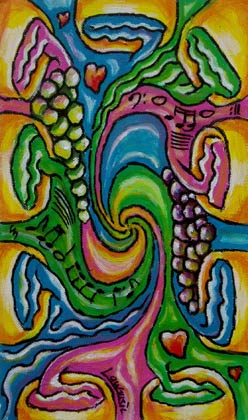 |

Card 1: 10 of Wands
The intensity of the Nine of Wands diminishes in the Ten of Wands. The colours are paler; it seems more difficult to hold the wands together; at the same time the small flames are burning both hands, the leaves are beginning to wither.

Card 2: 8 of Swords
The swords look like a cage. The eye is closed; it is looking into the inner vision; it is trying not to be aware of its own feelings. Some of the fingers are being dipped in the water; there is already contact here. The colours blue and pink show the strong contrast between understanding and emotions, which are trying clear the way for themselves.

Card 3: Queen of Swords
The queen is holding the butterfly carefully on her lap. At the same time, she is showing the detached chain and is banishing the black butterfly to the guillotine.
The blood on the ground shows clearly that the apparatus has already been used. She does not look callous; instead, she looks grievous and resolute. Her collar, studded with 15 precious stones, indicates she is sometimes struck dumb by little devils, the result of painful experiences.

Card 4: 4 of Swords
Three swords are holding a violet cauldron, under which a fire is burning. Something is being "extracted". The violet colour indicates a spiritual process. The sun is setting; nothing more will happen today. To sleep on it will help.
Tomorrow it might be possible to grasp the fourth sword and to take the right path in further conflicts. The path past the white flag is also possible.

Card 5: The Tower
A small ray of light shines through a crack in the wall and arouses our yearning for freedom and knowledge. The prison walls burst open and we can escape. We have already taken hold of the sword which stands for differentiation, consciousness and independent thought.
The monarch's insignia of the Emperor shows we are prepared to reconquer the seat on our own throne.

Card 6: Strength
A sceptre and a sword seem to be fighting. Water and fire, portrayed in striking red, stand for subconscious strength. They are kept under control by the symbols of earth and air, the conscious elements, portrayed by the sword (clarity), the house (stability) and the wall (limits, firmness). The violet colour of the wall also shows a penetration of the colours red and blue.
The trees also contain this mixture of the elements, but they are growing cautiously as well as the clouds, water, which so to speak, becomes air (gaseous). They also stand for integration, which on the one hand makes us more flexible but on the other hand obscures things. The lemniscates, which can be seen clearly in magic, can be found in the two trees in the top left corner. It illustrates swinging into the next bend.

Card 7: Prince of Swords
The strong helmet protects the prince, while, with eyes closed and head bent forward, he is demolishing the hard wall. Some bricks are falling down. A part of the wall looks like a bookcase.
This is all about ancient knowledge and opinions, the details of which are being asked about or, in the truest sense of the word, which are being blown into mid-air. However, with his eyes closed the prince cannot take into consideration what he is throwing around.

Card 8: The Empress
The illustration represents growth, nature and fertility. One can see certain fruits, including two pomegranates (fertility). The ears of corn represent the Empress' secret crown. The apple is in the shape of a heart. The three fish in the water symbolise feelings and emotionalism, as well as the Empress' figure three.
The illusion of a bowl, in which the fruit is lying, can be connected with conception, the uterus and with pregnancy. The trees present slow growth. The Empress is holding her sceptre in her left hand.

Card 9: 9 of Cups
The content of the nine cups is being poured over the picture and meets in a whirlpool in the middle. Three colours refer to the number three, out of which the number nine (3x3) exists. Notes (music/art), grapes (food/drink) and a heart (love/friendship) stand for areas which contain pleasure and well-being.
The colour red points to warmth, blue symbolises refreshment. The colour green can be understood as referring to a negative aspect on the card e.g., exaggerated personal pleasure.
